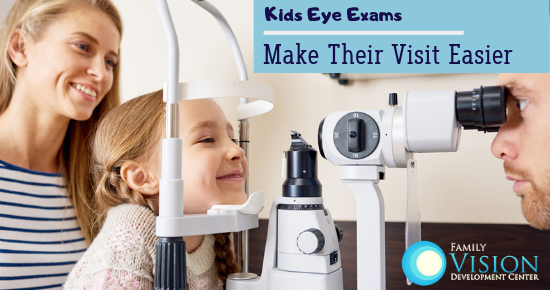A visit to the eye doctor can be a little overwhelming for young patients, especially if it’s the first visit. Even with a friendly, welcoming the staff, small children may feel shy or find vision testing machines and gadgets a little intimidating. Luckily, parents can make an optometrist visit much less daunting by following a few of these suggestions.
Don’t Keep Your Child in Suspense
Whether you’re 3 or 33, new situations are a lot less scary if you know what to expect. Before your child’s optometrist visit, explain the purpose of the visit. (You want to make sure he or she can see well.) Use age-appropriate language to explain the various steps in the eye examination process, which usually include a review of your child’s medical and vision history, a physical examination of the eyes and eyelids, and a visual assessment to determine if your child can see clearly.
During the assessment, your son or daughter will be asked to look at images or letters. Preschoolers may view several large capital Es that face in different directions. They’ll use their hands to indicate which direction the arms of the Es point. If your child knows the letters of the alphabet, he or she will read the traditional Snellen eye chart.
Eye drops may be used to dilate your child’s pupils. Dilation helps the optometrist view the retina, a light-sensing layer of cells that line the back of the eye. Although the drops aren’t painful, they will make your son or daughter’s vision a little blurry. Be sure to mention that the eye doctor will also look in your child’s eyes with a small light during the examination.
Choose the Best Appointment Time
Kids, like all of us, tend to feel a little more energetic at certain times of the day. If you want to make the optometrist visit as pleasant as possible, choose a time when your son or daughter is usually happy and well-rested. Scheduling visits during your child’s usual meal or nap time, immediately after a nap, or at the end of a long day can result in a cranky child who is reluctant to participate in the vision assessment.
Appointments usually last an hour or less, but may take longer if your child’s eyes are dilated or if you want to select eyeglass frames at the end of the visit.
Distract and Engage
The eye doctor will make every effort to see your child at the appointed time, but that doesn’t mean you won’t spend a little time in the waiting room completing paperwork. Prepare for any possible waiting time by bringing a few toys or books from home to keep your little ones occupied.
Offer a Little Reassurance
Some kids hop on the exam chair without prompting, while others aren’t quite as brave. If your young child is nervous or anxious, feel free to hold him or her in your lap during the assessment and examination. Older children may feel more confident if you stay by their sides or sit in a nearby chair during the visit with the optometrist.
When Should You Take a Child to Their First Optometrist Visit?
The American Optometric Association recommends that children visit the optometrist for the first time at 6 – 12 months old, followed by another visit between 3 and 5 years of age, then yearly visits from ages 6 to 18. However – it is important to remember that these are just guidelines. If you notice any issues with your child’s vision, always bring them in. Early detection of vision disorders can make a difference in the effectiveness of treatment, so it is better to be safe. Consult this Parent’s Checklist to look for early signs of vision impairment.
Contact Family Vision Development Center at 630-862-2020 or request an appointment online HERE

